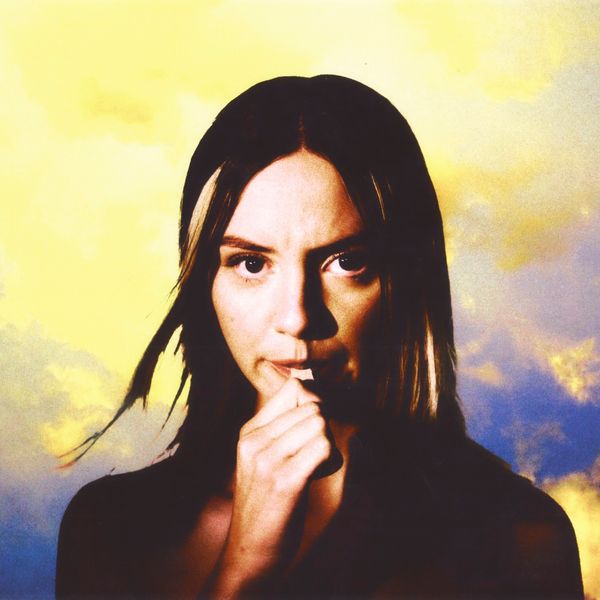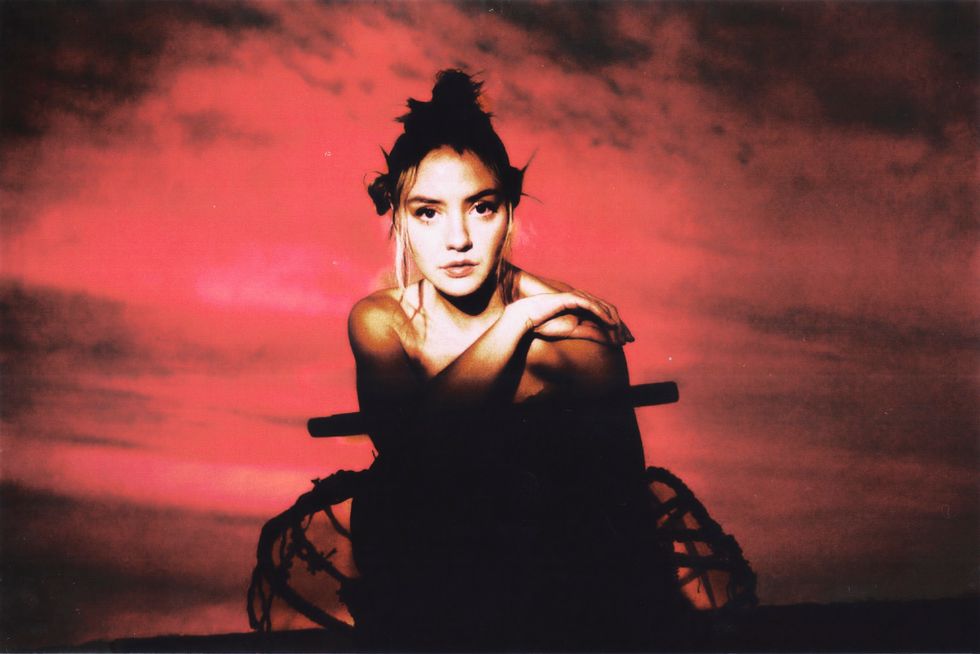
Dora Jar Unseals the Lid
By Tobias Hess
Sep 13, 2024I’m interviewing Dora Jar and she’s casually squirting a bottle of honey into her mouth. She imbibes the sticky sweetness as if it’s water and I see it all on my Zoom screen, but I still have to ask: “Is that pure honey?”
“Yeah,” she smiles, beaming. “It tastes like orange blossom.”
Jar has a childlike ability to see magic in the world. To those of us who have become weary in the face of life’s daily tedium, it can be equal parts refreshing and distressing to encounter such a wonderment. But after a few songs (or a few minutes talking with) the NYC-born, Nor-Cal-raised singer, you’ll likely find yourself converted. There is magic in the world, but sometimes it takes a gentle push to see it.
Throughout our conversation, Jar speaks of her encounters with voices and creatures almost like she’s reading from a storybook and not speaking about her own life. She recalls one experience she had when on mushrooms “that shook her to her core.” She was 19 and played music, but had not necessarily committed to the craft as a career. But then, during that trip, she heard a voice from the beyond: “It told me, ‘[You’re] a performer ... You're performing.’” Her voice turns gravelly to mimic the ethereal messenger. “My life flashed before my eyes, and I realized the ways I had not been acknowledging my grief and my confusion or shame.” That emotional opening led to a musical one and she dove further into her musical proclivities, reaching for the guitar to find new ways to process the emotions she felt so deeply.

The kind of musical output that followed is the kind that happens when wild talent meets hardened resolve, thus Jar’s style emerged. Her voice is soft yet cutting, and winds upwards towards a particularly powerful falsetto. Her lyrics tend to forgo simple play-by-plays, instead veering in and out of straightforward confession and cryptic symbology. Like on “Polly” a standout from her second EP, Digital Meadow, where she sings, “Imma rip my face and imma dance for you/ Lookin’ at the feeling of an empty room/ I wanna do everything a god would do.”
Jar cites Outkast as an influence, and indeed she has Andre 3000’s penchant for surprising yet apt references. But she also cites Stephen Sondheim’s deliciously emotive musicals as a touchstone. She remembers listening to the original cast recording of Into The Woods while observing a summer lightning storm in New York City. “The fear felt fun,” she says, recalling the thunder, before slipping into a wider reflection on her relationship to feeling and creation. “Sometimes sadness can feel meaningful in a good way.” She pauses to clarify. “Music decorates experience in a way that is totally validating.”
Her talent sparked bright and she harnessed it well, but nothing could have prepared her for the quick ascent to come. After releasing just a few songs, she was discovered by Billie Eilish, who would go on to ask her to open for her stadium tour. This all happened when Jar had barely played her first few shows. “[My career] was slow and then fast and then Whoa, what just happened?” Jar remembers. “I really embraced that moment, but I also had no experience. It was really cool to realize, Oh, I can handle this. I can perform in this giant space and stay present and still write songs.”

But even as her wild bravery led her to face the dragon of exposure with surprising ease, she still came home to a quiet world. It turns out the heat of thousands of screaming fans when you’re just starting out does have its toll eventually. “I was a deer in the headlight when all the action was over. [And then it was time] to write my first album.”
Her debut album, No Way To Relax When You’re On Fire became a chance to face a different monster, a quieter one, but a terror nonetheless: self-doubt, writer’s block, expectation, that dizzy feeling when you’re forging a path in uncharted water. Thankfully, though, yet another voice emerged to guide her.
“My mom and her best friend were doing ketamine therapy. Last minute, they invited me to do it with them,” she tells me. “I was lying on the floor in this Shibari bondage studio where they just happened to be having the treatment,” she laughs. “We were lying down with eye masks on. There was a sound bath happening. [And then there was] this voice saying ‘Life isn't just about an album,’ over and over again,” she recalls. “I was like, Oh, I gotta go live a little bit.”
And live she did. Over the course of writing and recording the 13-track album, Jar found herself in studios and sessions around the world, in Poland, Alaska, Ojai, California, Tennessee and New York. And along the way, she found her guides, producers/sages like the 1975’s George Daniel, Dijon’s sonic architect, Henry Kwapis and Ralph Castelli who brought her to record and write in Alaska — its perplexing vastness sparking something deep within her.

A line from a haiku her mom’s ex-boyfriend wrote — “rough water is still water” — found itself on the album’s opening, “This Is Why,” and then became a quiet summary of her thinking. A fluid sensibility emerged and she found herself contending with what it means to flow with the tides of living, like on album standout “Ragdoll” where she gives up control and circles the drain of sexual escape. “Make me lose control/ Throw me like a ragdoll/nCatch my edge again,” she sings, her voice lilting towards fearsome bliss. But at other times, she manages to try to shift the rushing stream, like on “Puppet,” which she wrote after she shot a gun for the first time in Alaska. The rush and adrenaline inspired a new desire for control, and in the song she sings as the proverbial “puppet,” “cut[ting] the string” of a music industry that often discourages artists’ agency.
Sonically, the album took on similarly fluid gestures: fuzzed guitars blend with softer acoustic layers blend with retro mellotron synths blend with Jar’s vocals which often take on the rhythmic tick of rap music, her words bouncing against each other as both expressions of pure sound and meaning. Indeed, a resonant nonsense defines some songs, like on standout track, “Timelapse”, when she begins softly, yet spryly: “Don't stop, jackpot, blacked out, float down/Keep on goin' like a bubble in a bong/Don’t trip on the cord, this is NYC, step on out.” Her whispered words buzz and bang with syllabic fervor in the vein of Fiona Apple’s freewheeling poetics, but she always lands on a simplicity that can leave you stunned. Its chorus is a quiet repetition. She bluntly asks, “Who am I?” over beds of flute. “I've always been plagued with the big questions,” Jar shares. “And whatever I'm feeling, it's the exponential version of it.”
Though we don’t necessarily find a final answer to that lofty pondering, we do get to listen to Jar’s inquiries, her experiments in understanding. It’s like staring at mushrooms or bugs or moss on a redwood. You can stare and stare and never know the “why” behind all that creation. But you can still learn something. You can feel something, too.
Photography: Haley Appell
MORE ON PAPER
Entertainment
Rami Malek Is Certifiably Unserious
Story by Joan Summers / Photography by Adam Powell
Story by Joan Summers / Photography by Adam Powell
14 November
Music
Janelle Monáe, HalloQueen
Story by Ivan Guzman / Photography by Pol Kurucz/ Styling by Alexandra Mandelkorn/ Hair by Nikki Nelms/ Makeup by Sasha Glasser/ Nails by Juan Alvear/ Set design by Krystall Schott
Story by Ivan Guzman / Photography by Pol Kurucz/ Styling by Alexandra Mandelkorn/ Hair by Nikki Nelms/ Makeup by Sasha Glasser/ Nails by Juan Alvear/ Set design by Krystall Schott
27 October
Music
You Don’t Move Cardi B
Story by Erica Campbell / Photography by Jora Frantzis / Styling by Kollin Carter/ Hair by Tokyo Stylez/ Makeup by Erika LaPearl/ Nails by Coca Nguyen/ Set design by Allegra Peyton
Story by Erica Campbell / Photography by Jora Frantzis / Styling by Kollin Carter/ Hair by Tokyo Stylez/ Makeup by Erika LaPearl/ Nails by Coca Nguyen/ Set design by Allegra Peyton
14 October
Entertainment
Matthew McConaughey Found His Rhythm
Story by Joan Summers / Photography by Greg Swales / Styling by Angelina Cantu / Grooming by Kara Yoshimoto Bua
Story by Joan Summers / Photography by Greg Swales / Styling by Angelina Cantu / Grooming by Kara Yoshimoto Bua
30 September
Music
Demi Lovato Is No Joke
Story by Ivan Guzman / Photography by Jason Renaud / Styling by Chris Horan/ Makeup by Loftjet / Set design by Allegra Peyton
Story by Ivan Guzman / Photography by Jason Renaud / Styling by Chris Horan/ Makeup by Loftjet / Set design by Allegra Peyton
15 September




